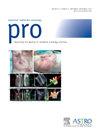粒子疗法实用入门》。
IF 3.4
3区 医学
Q2 ONCOLOGY
引用次数: 0
摘要
目的:粒子疗法是一种前景广阔的治疗技术,正在得到越来越普遍的应用。尽管质子束疗法仍是最常用的粒子,但在临床前和临床环境中已使用了多种其他重离子,每种粒子都有自己独特的特性。本实用综述旨在总结所研究粒子之间的差异,讨论它们的放射生物学和物理特性,并对现有的临床数据进行补充综述:在 PubMed 数据库中使用与每种粒子相关的检索词进行了搜索。纳入了相关的放射生物学、物理学和临床研究。对这些文章进行了总结,以便为临床医生提供实用资料:我们的叙述性综述共纳入了 113 篇文章和文本。目前,质子束疗法的数据最多,应用也最广泛,其次是碳、氦和中子。虽然氧、氖、硅和氩已被用于临床,但作为单一疗法,它们在未来的使用可能仍然有限:本综述总结了每种临床相关粒子的特性。质子、氦和碳可能仍将是最常用的粒子,尽管多离子疗法是一种新兴技术。本文章由计算机程序翻译,如有差异,请以英文原文为准。
A Practical Primer on Particle Therapy
Purpose
Particle therapy is a promising treatment technique that is becoming more commonly used. Although proton beam therapy remains the most commonly used particle therapy, multiple other heavier ions have been used in the preclinical and clinical settings, each with its own unique properties. This practical review aims to summarize the differences between the studied particles, discussing their radiobiological and physical properties with additional review of the available clinical data.
Methods and Materials
A search was carried out on the PubMed databases with search terms related to each particle. Relevant radiobiology, physics, and clinical studies were included. The articles were summarized to provide a practical resource for practicing clinicians.
Results
A total of 113 articles and texts were included in our narrative review. Currently, proton beam therapy has the most data and is the most widely used, followed by carbon, helium, and neutrons. Although oxygen, neon, silicon, and argon have been used clinically, their future use will likely remain limited as monotherapy.
Conclusions
This review summarizes the properties of each of the clinically relevant particles. Protons, helium, and carbon will likely remain the most commonly used, although multi-ion therapy is an emerging technique.
求助全文
通过发布文献求助,成功后即可免费获取论文全文。
去求助
来源期刊

Practical Radiation Oncology
Medicine-Radiology, Nuclear Medicine and Imaging
CiteScore
5.20
自引率
6.10%
发文量
177
审稿时长
34 days
期刊介绍:
The overarching mission of Practical Radiation Oncology is to improve the quality of radiation oncology practice. PRO''s purpose is to document the state of current practice, providing background for those in training and continuing education for practitioners, through discussion and illustration of new techniques, evaluation of current practices, and publication of case reports. PRO strives to provide its readers content that emphasizes knowledge "with a purpose." The content of PRO includes:
Original articles focusing on patient safety, quality measurement, or quality improvement initiatives
Original articles focusing on imaging, contouring, target delineation, simulation, treatment planning, immobilization, organ motion, and other practical issues
ASTRO guidelines, position papers, and consensus statements
Essays that highlight enriching personal experiences in caring for cancer patients and their families.
 求助内容:
求助内容: 应助结果提醒方式:
应助结果提醒方式:


